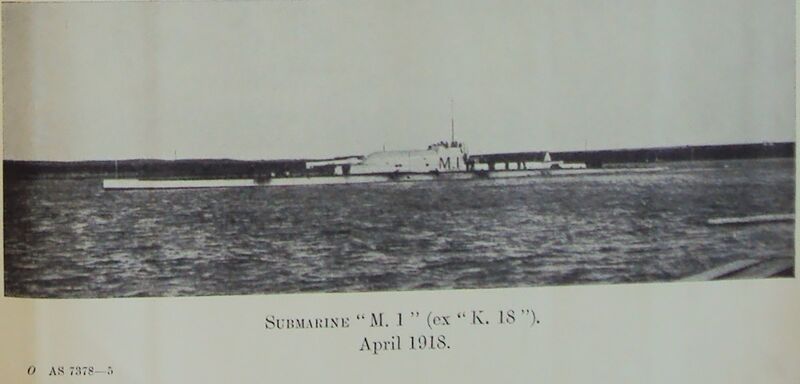"M" Class Submarine (1917): Difference between revisions
From The Dreadnought Project
Jump to navigationJump to search
(Update ships) |
No edit summary |
||
| (5 intermediate revisions by 2 users not shown) | |||
| Line 1: | Line 1: | ||
[[File:TH21Plate9c.jpg|thumb|800px|'''''M 1'' shows off her unusual armament.'''{{UKTH21|Plate 9}}]] | |||
Three of four projected '''"M" class''' submarine monitors were completed for the [[Royal Navy]]. | Three of four projected '''"M" class''' submarine monitors were completed for the [[Royal Navy]]. | ||
| Line 32: | Line 33: | ||
|- align=left | |- align=left | ||
| {{Template:UK-M3}} | | {{Template:UK-M3}} | ||
|[[Armstrong]] | |[[Armstrong, Whitworth & Company]] | ||
| | | | ||
|19 Oct, 1918 | |19 Oct, 1918 | ||
| Line 39: | Line 40: | ||
|- align=left | |- align=left | ||
| {{Template:UK-M4}} | | {{Template:UK-M4}} | ||
|[[Armstrong]] | |[[Armstrong, Whitworth & Company]] | ||
| | | | ||
|20 Jul, 1919 | |20 Jul, 1919 | ||
| Line 54: | Line 55: | ||
The 12-in gun could train 15 degrees to either side, elevate 20 degrees or depress 5 degrees. | The 12-in gun could train 15 degrees to either side, elevate 20 degrees or depress 5 degrees. | ||
It proved | It proved remarkably workable, and even after the war the British were considering how this might be preferable as an anti-submarine weapon to firing a spread of torpedoes. The submarine was able to transition from periscope depth to firing depth in 25 seconds, and to return to periscope depth after firing in 15 seconds.{{UKTHVol3Part21|p. 8}} Unfortunately, the gun had to be reloaded in the surface. | ||
===Torpedoes=== | ===Torpedoes=== | ||
| Line 62: | Line 63: | ||
M 3: | M 3: | ||
* four 21-in tubes forward, eight torpedoes | * four 21-in tubes forward, eight torpedoes | ||
===Mines=== | |||
M 3 was converted to a minelaying submarine in 1927. She had a capacity for 100 mines, which were laid off the stern. | |||
==See Also== | ==See Also== | ||
| Line 108: | Line 113: | ||
pend= | pend= | ||
builder=[[Vickers]]{{Conways1906|p. 92}} | builder=[[Vickers]]{{Conways1906|p. 92}} | ||
order= | order=May, 1916{{UKTHVol3Part21|p. 40}} | ||
laid= | laid= | ||
launch=19 10 18{{Conways1906|p. 92}} | launch=19 10 18{{Conways1906|p. 92}} | ||
| Line 121: | Line 126: | ||
name=M 3 | name=M 3 | ||
pend= | pend= | ||
builder=[[Armstrong]]{{Conways1906|p. 92}} | builder=[[Armstrong, Whitworth & Company]]{{Conways1906|p. 92}} | ||
order= | order=Aug, 1916{{UKTHVol3Part21|p. 40}} | ||
laid= | laid= | ||
launch=19 10 18{{Conways1906|p. 92}} | launch=19 10 18{{Conways1906|p. 92}} | ||
| Line 136: | Line 141: | ||
pend= | pend= | ||
builder=" | builder=" | ||
order= | order=" | ||
laid= | laid= | ||
launch=20 7 19{{Conways1906|p. 92}} | launch=20 7 19{{Conways1906|p. 92}} | ||
Latest revision as of 20:18, 2 March 2020

M 1 shows off her unusual armament.[1]
Three of four projected "M" class submarine monitors were completed for the Royal Navy.
Only M 1 saw war service.
| Overview of 4 vessels | |||||
|---|---|---|---|---|---|
| Citations for this data available on individual ship pages | |||||
| Name | Builder | Laid Down | Launched | Completed | Fate |
| M 1 | Vickers | 9 Jul, 1917 | Collision 12 Nov, 1925 | ||
| M 2 | Vickers | 19 Oct, 1918 | Foundered 26 Jan, 1932 | ||
| M 3 | Armstrong, Whitworth & Company | 19 Oct, 1918 | Sold Feb, 1932 | ||
| M 4 | Armstrong, Whitworth & Company | 20 Jul, 1919 | Cancelled 1918 | ||
Armament
Guns
- one 12-in 40 cal Mark IX, 50 shells
The 12-in gun could train 15 degrees to either side, elevate 20 degrees or depress 5 degrees.
It proved remarkably workable, and even after the war the British were considering how this might be preferable as an anti-submarine weapon to firing a spread of torpedoes. The submarine was able to transition from periscope depth to firing depth in 25 seconds, and to return to periscope depth after firing in 15 seconds.[2] Unfortunately, the gun had to be reloaded in the surface.
Torpedoes
M 1, M 2:
- four 18-in tubes forward, eight torpedoes
M 3:
- four 21-in tubes forward, eight torpedoes
Mines
M 3 was converted to a minelaying submarine in 1927. She had a capacity for 100 mines, which were laid off the stern.
See Also
Footnotes
Bibliography
| "M" Class Submarine | |||||||||||||||||||||||||||||||||||||||||||||||||||||||||||||||||||||||||||||||||||||||||||||||||||||||||||||||||||||||
| M 1 | M 2 | M 3 | M 4 | ||||||||||||||||||||||||||||||||||||||||||||||||||||||||||||||||||||||||||||||||||||||||||||||||||||||||||||||||||||
| <– | "L" Class | Submarines (UK) | "R" Class | –> | |||||||||||||||||||||||||||||||||||||||||||||||||||||||||||||||||||||||||||||||||||||||||||||||||||||||||||||||||||